
For whom the bell tolls

View from our terrace of parish church bell tower 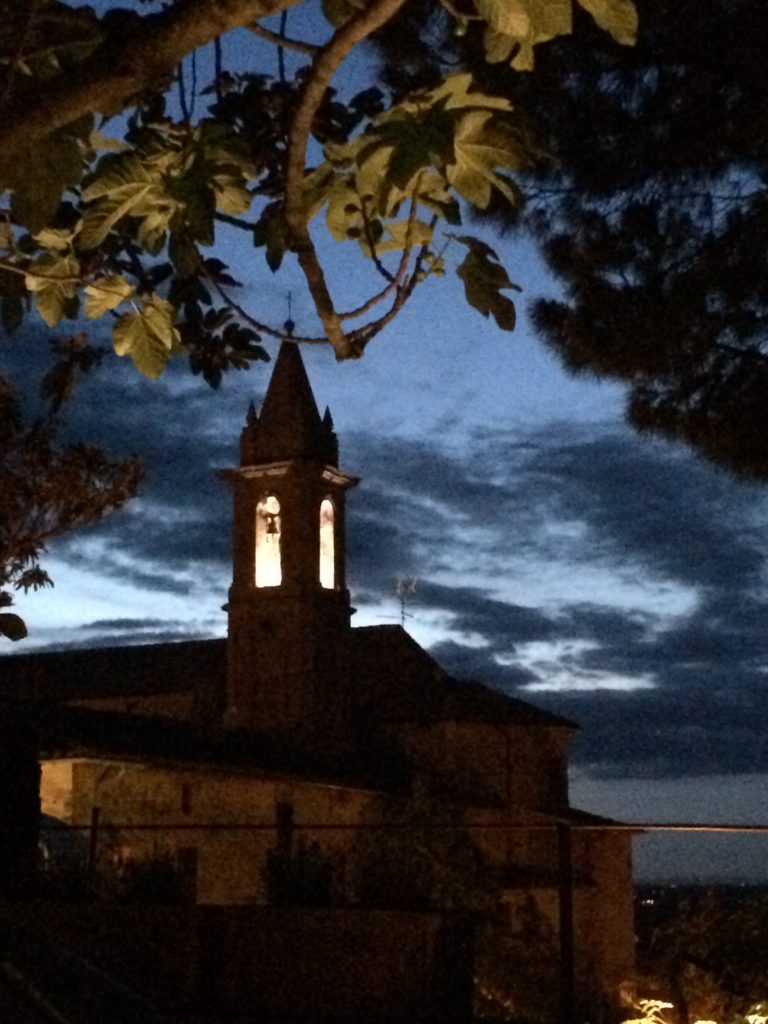
They toll for me. And for everyone in this amazingly well preserved hilltop town that time forgot. I had one very specific ‘must’ on my wish list when deciding where we would relocate our lives. I wanted to live where I can hear the bells ring.
Where the telling of time didn’t require a designer watch on my wrist but a moment to stand still and count the number of times the bell tolled. I wanted a simple life. That’s what we’ve found in the medieval village of Paciano, carved into the sloping hills of Mount Petravella.

Paciano is listed as ‘one of the most beautiful villages in Italy’. And when you make your first visit here, you will soon see why. Perched at almost 400 meters above sea level, Paciano looks down at dense oak and chestnut forests, shimmering olive groves and the pale green waters of Lago Trasimeno. It is lush, verdant, and rich with natural beauty.
Walking trails to nearby Monte Pausillo take you through one of the richest habitats of Mediterranean wild-life, not to mention offer up incredible eagle-eye views of three lakes: Umbria’s Trasimeno and neighboring Tuscany’s Lake Chiusi and Lake Montepulciano. There is a wide variety of hiking and mountain biking trails right outside the town gates – a true nature lover’s paradise.
Paciano itself is a literally a castle. The original Paciano stood higher on the mountainside but was destroyed, either by an earthquake or sacking, or maybe both. I’ve never been able to get a straight answer on what happened. The new Paciano was built in the 1400s where it still stands, virtually unchanged. A local census around that time recording the number of ‘hearths’ (representing the number of homes) referred to the village as Castrum Novum or ‘New Castle’, with a total of 44 hearths. It’s amazing to think our house was likely one of those ‘hearths’ recorded. Our house is one of the older homes built on the outside castle walls and has the original fireplace still intact.
Today, Paciano retains its character as a medieval castle. Many visitors describe a visit here as a stroll back in time. It is considered one of the best-preserved medieval villages in Italy. You won’t see any telephone or electrical wires hanging across the narrow streets or running down the stone walls. They are all buried to maintain the original character of the village.
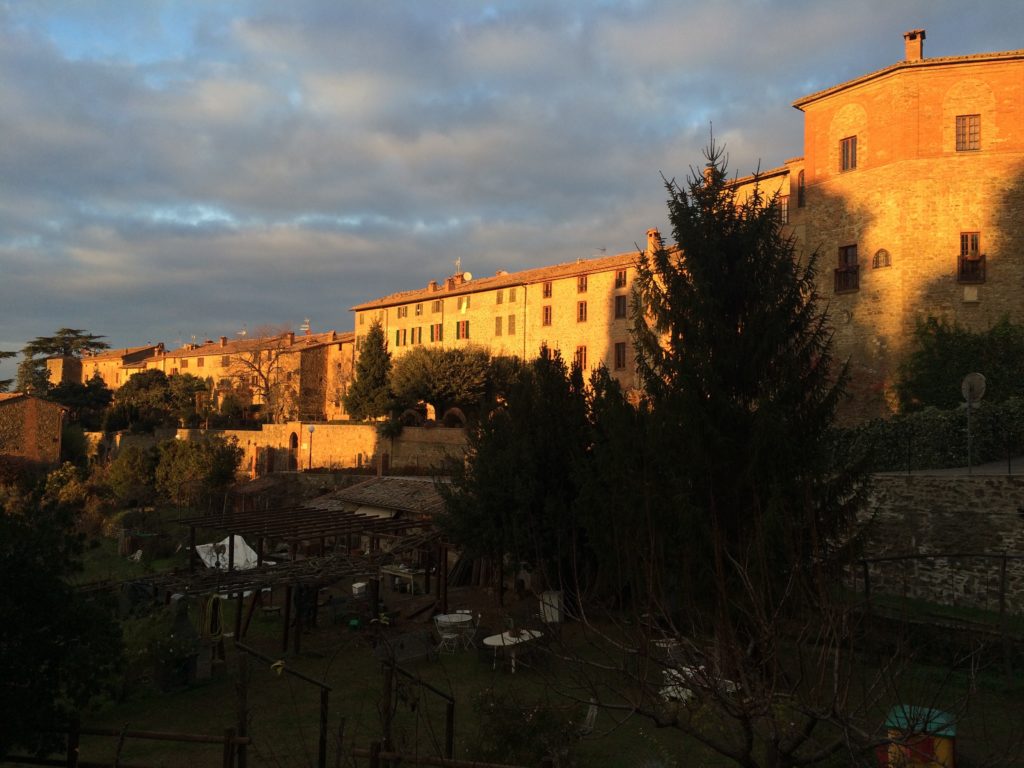
There are defense walls and eight towers guarding the town. Most of these towers were converted to dwellings in the 17th century. Inside the town, three parallel streets connected by picturesque orthogonal alleys hide palaces, old defence structures and churches. Our house, Casa Vistaverde is located on one of the main street, just a few doors up from Porta Fiorentina.
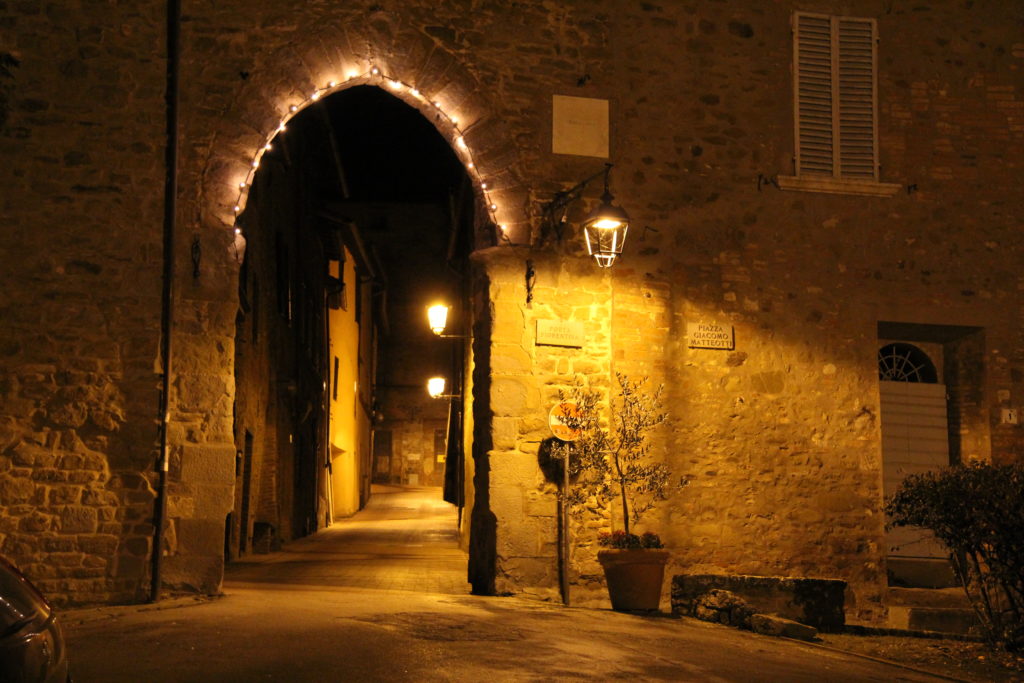
Porta Fiorentina 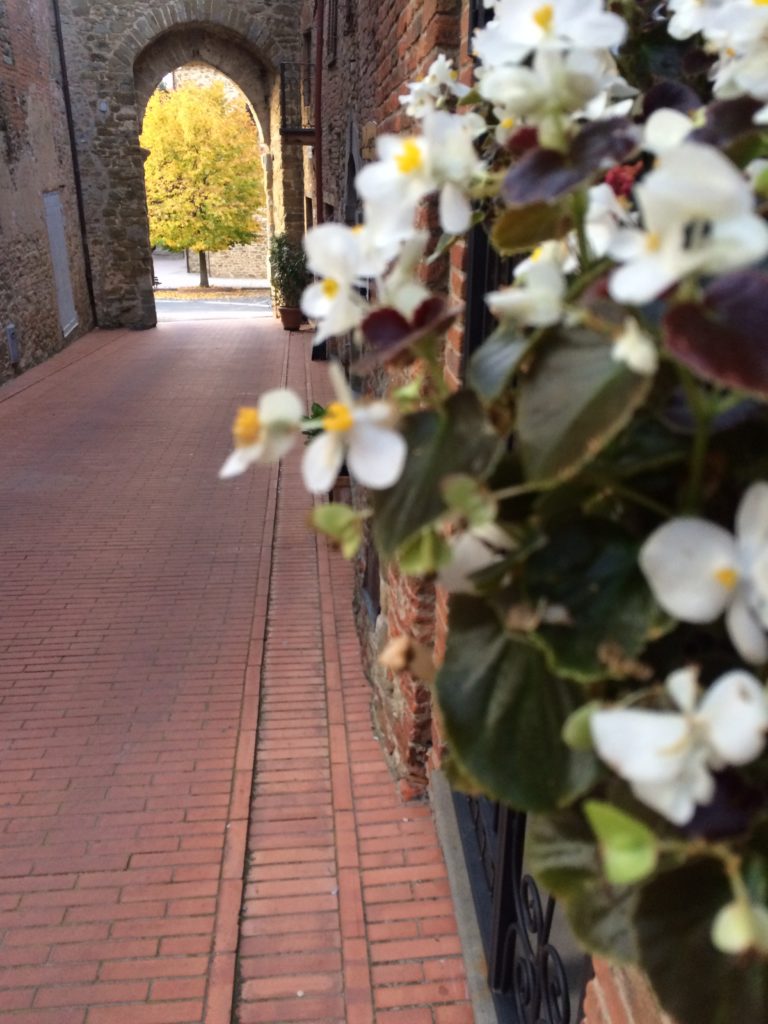
Porta Fiorentina
The town is accessible through its three arched gates: Porta Fiorentina, Porta Perugino and Porta Rastrella. I remember one of the first things I learned when I visited a medieval town in Italy is that all of the Porta (gates) are named according to the direction they face e.g. Porta Fiorentina faces Florence and Porta Perugino faces Perugia. Well, almost all of them. One of the main gates allowing access within the castle walls is the Porta Rastrella (or ‘rake’). The rake symbol carved into the arch of the old gate, along with a fleur-de-lis and the date Anno Domini MCCC (1300 AD) can still be seen today. I’m not sure why this gate is named for a rake. But I’m sure some historian out there will be happy to share the answer with us.
Paciano has the smallest local council or comune in Umbria, with less than 1,000 residents spread over 16 square kilometers. In the historical center, where we live, there are about 100 houses within the walls. But while it may be small, Paciano has an abundance of art and history. Here is a link to more on the history and art works you can find in our beautiful village:
The area was first inhabited by the Estrucans, the pre-Roman people who are documented as being in the area as far back as the 4th century BC. We were in a friend’s house in the historical center a while back and I noticed these beautiful urns on the top shelf of his bookcase, some with faded black, almost Aztec-style designs. When I asked where they came from, he said casually, ‘Oh, they’re Etruscan’. How wonderful to find such ancient treasures in your own backyard and be able to carry them home to put on display in your historical home.
That’s one of the many things I love about Italy, its rich history, the layers of humanity that make up modern day life here. The past is only ever a few steps away.
This morning, I’m lost in my garden, toiling away unaware of time passing. Then I hear them. The bells are ringing. I take off my gloves and close my eyes. I listen and count. It’s lunchtime. And as I stretch and breathe in the fresh, Umbrian air, I take a moment to remember what is truly beautiful about Paciano. Her people. It’s the young, old, and somewhere in-between villagers of Paciano who have opened up their hearts to us and given us a community. A home.
We are filled with love and gratitude for the Italians and the foreigners or straniere who make Paciano such a special place to live. Stay tuned for an upcoming post on the cast of unique characters who make up daily life in our medieval village.
A presto
Anna
Here is additional information on some of the churches of Paciano.
Paciano may be small but it has a plethora of churches. There are seven churches located both within and outside the church walls. I’m including a brief write-up one some of the most important ones. The information is collected from various online sources and as usual, any factual errors are my own. As noted, I am not a historian. I only wish to share and inspire.
(1) The Church of Saint Carl Borromeo
We know for sure this church has been here since 1612 but its origins are not known. In 1802 it was restored and repainted. It has a single altar adorned with a very valuable painting from the Umbrian school. It’s also home to a 17th century wooden Dead Christ. This life-size Christ is carried in procession throughout the streets of Paciano on Good Friday, as it has been for the past 300 years. What’s most fascinating about this church is it is only open for three days a year, from Good Friday until Easter Sunday when it is locked up again until the following Easter. I will share more details of this beautiful annual ritual in an upcoming post.
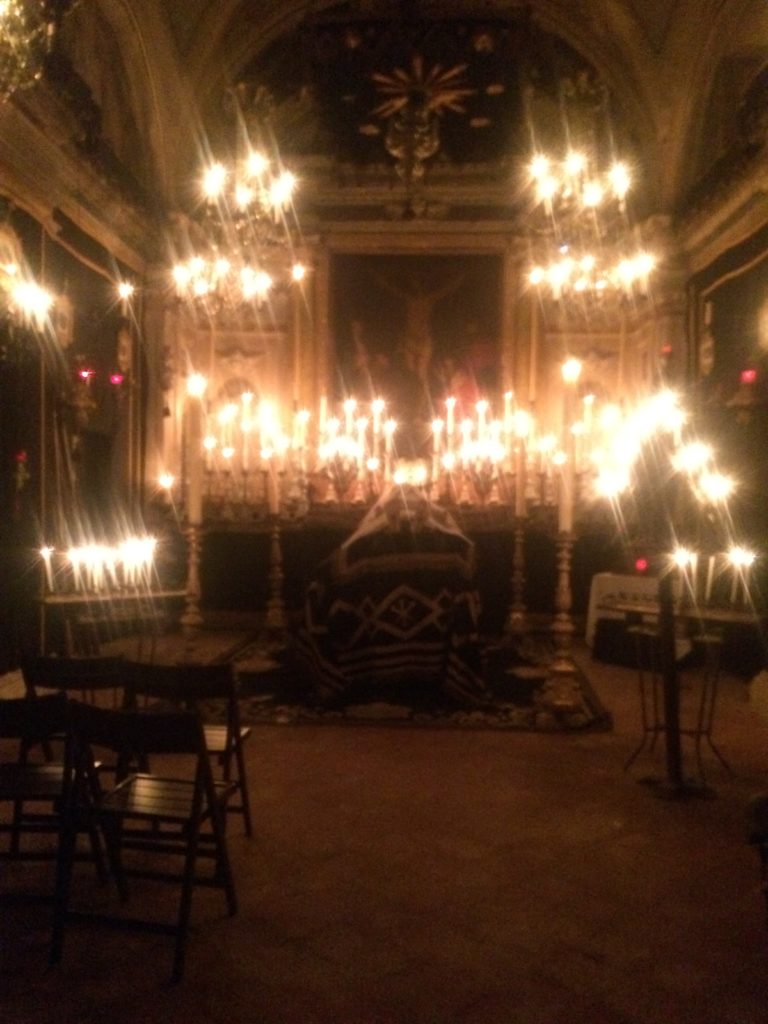
(2) The Church of the S.S. Concezione and of San Giuseppe
This was the first church to be erected inside new Paciano. It is also called “Chiesa dentro” or the “inside church”. It retains the original vaulted roofing, known as “grottone”. The church was restored between 1796 and 1815.
(3) The Parish museum and art gallery
Entering via the short and steep staircase, you come face-to-face with an enormous fresco situated in the middle of the wall. Alongside the fascinating religious exhibits, you’ll find interesting Etruscan finds of the 4th Century B.C on displa, including ceramics, bronzes, oil-lamps and other materials.
(4) The Church of Saint Mary Assumption to Heaven
This is Paciano’s parish church. Restoration work brought to light a document dating the original church back to 1014. The impressive bell tower as it stands today is a more recent addition. The original church bells were housed in a simple bell gable.
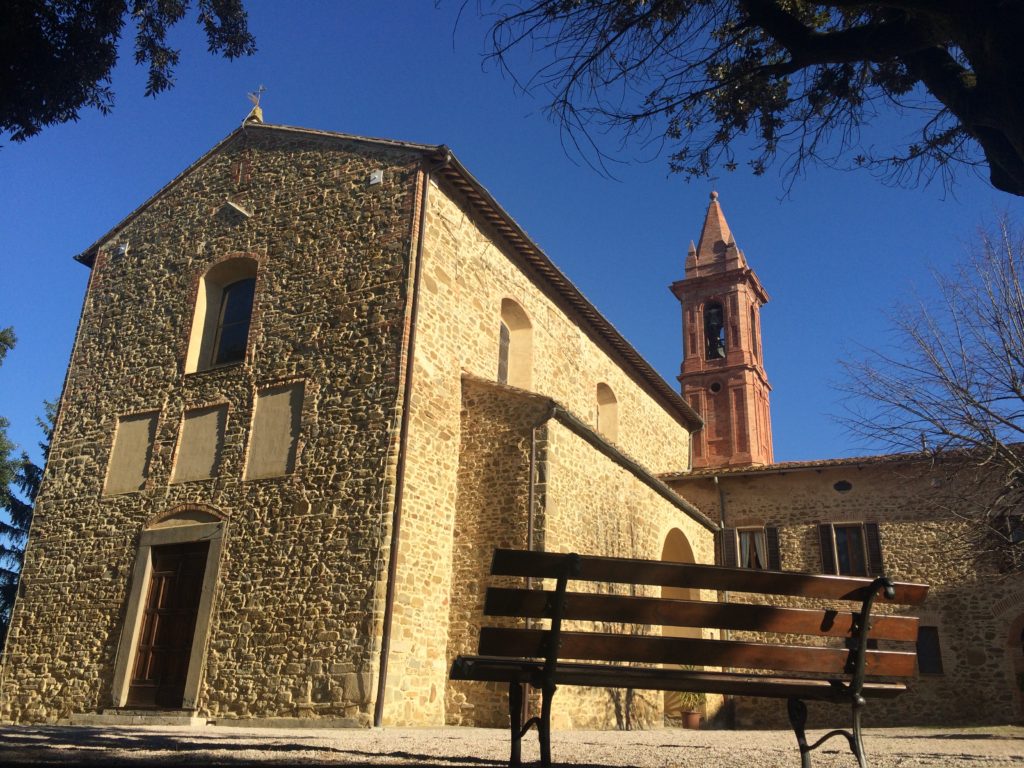
(5) The Church of the Madonna della Stella (or “Star”).
The construction of the church, dedicated to the Madonna della Stella, dates back to 1572. The lateral chapel dates back to May 1579.
Legend and history The legend of the Madonna della Stella is one of the most told in Paciano. Apparently, in 1561 a devout pilgrim staying in a nearby hospice saw – for three nights in a row – a star about two hundred meters outside the village from the Porta Perugina entrance. The pilgrim rushed to tell the local population about this occurrence and everybody went to see for themselves. Soon word reached the bishop of nearby Chiusi and he granted permission for a church to be built on the site of the apparition.The entire population of Paciano, together with citizens of neighbouring towns, provided money and work to help build the church. It went up in very short time. The date 1572 is inscribed in the architrave over the greater altar. The two lateral naves were constructed after that. The date 19th of May is inscribed at the top of the side of the Crucifixion altar in the nave on the left. Now every May there is a special service and lunch in honor of this special day, commemorating the completion of The Madonna della Stella church. I will share our special experience at this anniversary lunch in another post.
(6) The Parish Church of S.S. Salvatore of Ceraseto
This is one of old Paciano’s surviving churches; it is dedicated to S.S. Salvatore. The foundation date is unknown, but it is thought to be an ancient place of worship, maybe one of the first in the Paciano area. There is evidence that the church was constructed on the remains of a pagan temple.
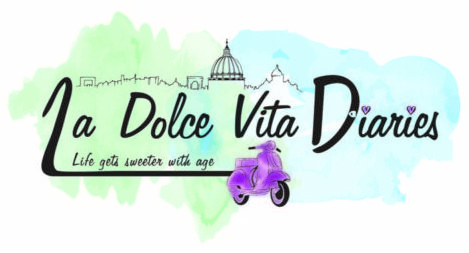
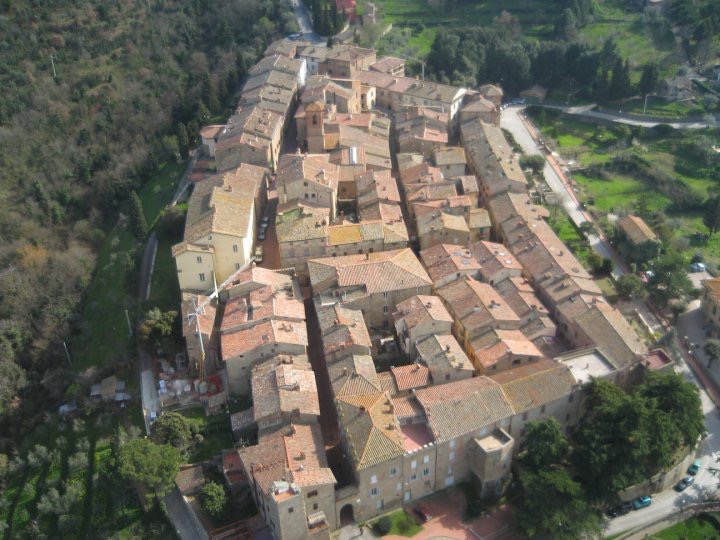

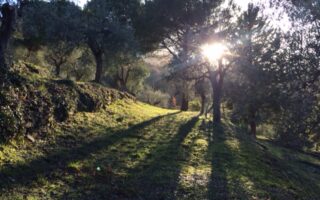
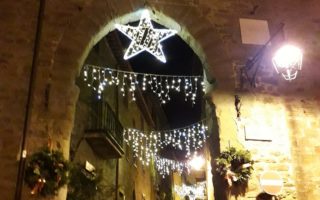
Just found a house for sale here and stumbled upon your article. It sounds so lovely there.
We are looking to buy a small place to stay (and possibly rent out (??)) Would you be willing
to share more about the town and your area with me?
I look forward to hearing from you.
Respectfully,
Lisa Borghi
Thank you so much for reaching out Lisa. I apologize for the late reply. There was a glitch with my messages and just received a backlog from months ago. Have you found a place yet?
Anna, I throughly enjoyed this and other posts (especially touched by the story of the amazing little dog you rescued and vice versa), both because of the informative content and the personal writing style.
You are a one woman PR program for Italy. We will be visiting Italy for the first time and will be staying in an agriturismo near Paciano and are excited. This blog has certainly helped.
We wish you continued contentment in Paciano and look forward to more of your enjoyable blogs. Beth
Thank you so much Beth for your wonderful feedback. I apologize for the late reply but someone missed your message earlier. Please do contact me when you are in Paciano and perhaps we can meet for a coffee. When do you arrive?
Hi Anna,
Thank you for your post. We have bought a flat close to Paciano and it was lovely to read about the village. Hope to see you around.
Regards,
Agata
That’s wonderful Agata!! where are you located? Welcome to Paciano